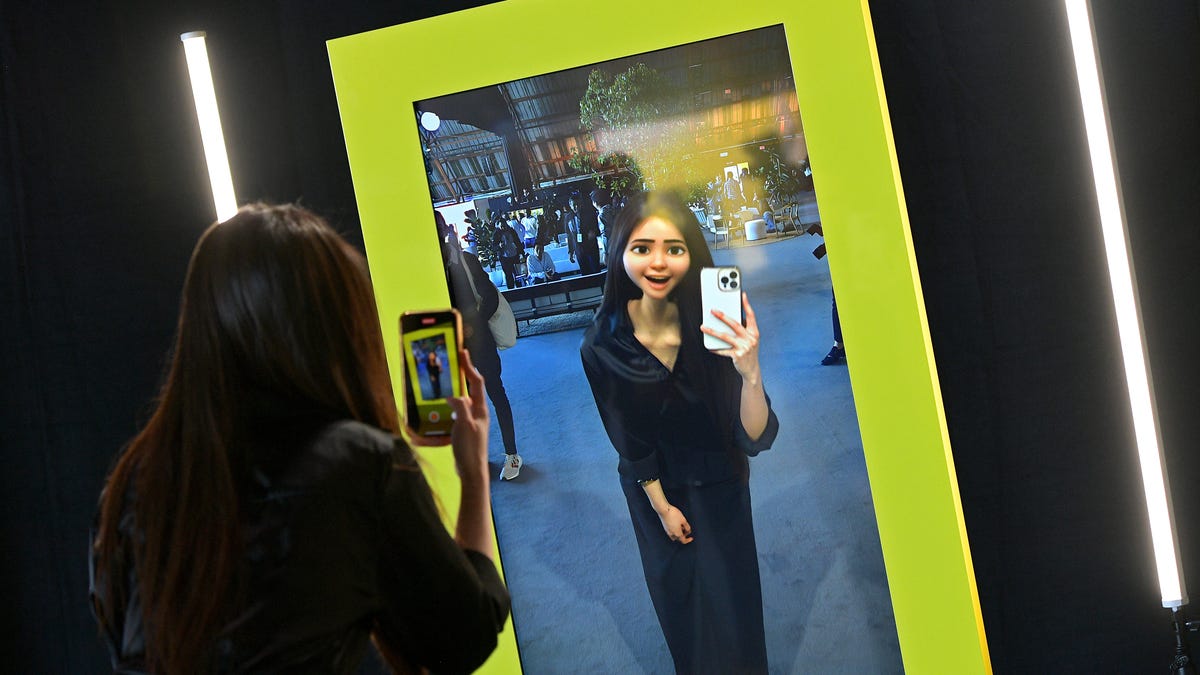How You Might Use Snapchat AR Without Even Realizing It

You step into a store to look for some new shirts. They don’t have the one you want, but there’s a mirror hanging on the wall. It shows an image of you with the shirt you want, projected onto your body like a magic trick. Is this how you “try” on your next outfit?
Snap’s AR mirror, one of several new initiatives the company announced at its most recent developer conference, seems like a familiar idea. Really, it’s a giant phone screen showing AR apps similar to those you can already launch on Snapchat or elsewhere. But Snap’s push to place more instances of augmented reality in the real world reveals a hunger to show more people what’s possible in a world where AR glasses still haven’t gone mainstream. After all, not many people use AR on their phones as a daily habit, unless it’s to play around with face filters.
Apple’s long-awaited mixed reality headset looks like it’s around the corner. Meta continues to try to push toward an everyday pair of AR glasses. Qualcomm, Google and Samsung are aligning to figure out a future product too. The only problem right now is, there aren’t many people that want to wear things on their faces.
Meanwhile, augmented reality — in this case, overlaying virtual visuals and audio onto the real world — has been on phones for over half a decade. Again, not everyone necessarily feels compelled to launch an app like Snapchat to create face filters or try on virtual shoes. Snap’s recent moves at its developer conference, where it also laid out integrations of its AR filters into live sporting events broadcast cameras, concert and festival apps, hints that this may become something you might be using, or even have used, very soon — maybe without even realizing it was technically AR.
“The goal with augmented reality, and a lot of this technology, is for it to just fall into the background and enhance the overall experience and then to provide value and utility in your lives,” Sophia Dominguez, Snap’s director of AR Partnerships, said in a conversation with CNET. In a sense, it’s the same goal as where generative AI is pushing: to be a layer.
Snap’s push toward AR shopping tools mirrors where the rest of AR has already surfaced on Google, in Apple’s ARKit and across a lot of the web. Virtual glasses and shoe try-ons, putting appliances or furniture in your home, looking at how a TV might look on your wall — these are all reasons I use AR at home. But again, a lot of the current implementations expect me to launch the app or try it myself on my phone. Snap’s in-store AR mirror is trying to make people aware the idea is possible, even if you’ve never used AR in Snapchat or any other app before.
There have been indications that AR shopping leads to more sales: according to stats that Snap quoted of retail partners, they may lead to a greater likelihood of purchase or a deeper connection to a product.
Snap has been working on AR overlays that can appear at concerts or events, either showing maps or visual effects.
Snap’s other big push — to live entertainment venues like concerts through a partnership with Live Nation — looks like a way to make its visual effects feel even more real and massively social. Snap’s already had a number of multi-person AR Lens experiences that can be seen by groups on different phones and layered over real-life locations. Concert AR is that same idea but more integrated. Music and AR activations have been a bit of a trend lately: Google and the Gorillaz had an AR concert app that worked in New York’s Times Square.
“Everyone’s phone is up, right? People have their phones out all the time there,” Dominguez said of Snap’s moves into live music. “And if augmented reality can then overlay computing onto the world and provide more value to you, of course you’re gonna do that. We want to be the technology layer that enables that, whether that’s like on Snapchat or through off-platform capabilities into other sorts of products like AR mirrors.” Dropping those AR experiences in an actual concert app may also mean more people actually use them.
Snap’s approach — enabling more apps and services to get the company’s AR Lenses (like Microsoft Teams getting Snapchat AR filters) — feels similar to how OpenAI is enabling ChatGPT plugins in other services: eventually, maybe, there’s an AR layer that feels like it’s everywhere, instead of stuck in a few apps.
That type of approach may also be necessary as insurance for what comes next. With new players like Apple, Google and Samsung, plus the disruptive possibilities of generative AI (which is also a focus for Snapchat, with its new free AI chatbot), AR may need to feel as always-ready and automatic as voice assistants do now. And maybe, if companies like Snapchat begin easing people into using AR more often, the idea of augmented reality glasses — which Snap is already working on down the road — might not seem so strange.
Source: CNET















